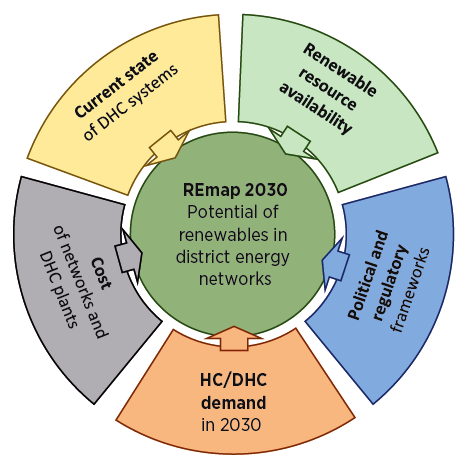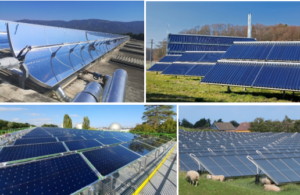IRENA: Renewable District Heating and Cooling Roadmap to 2030
April 27, 2017
 The International Renewable Energy Agency (IRENA) has published an industry roadmap for Renewable Energy in District Heating and Cooling (DHC) as part of its REmap 2030 project. This study analysed the current state of the DHC market in eleven countries – with a focus on district heating in seven and one on district cooling in the other four – and examined the long-term potential of the two technologies in these countries (see the attached PDF). The countries chosen for the study have distinctly different market environments. Two of them are Denmark and Switzerland, which have had the highest share of renewables in their energy supply (around 40 %); a third one is China, the largest market for DHC today, but one on which renewable energy has yet to play a role at all. The chart shows the key factors impacting the potential of renewable DHC. The aim of the renewable energy roadmap (REmap) programme is to show a path towards doubling the share of renewables in the global energy mix by 2030.
The International Renewable Energy Agency (IRENA) has published an industry roadmap for Renewable Energy in District Heating and Cooling (DHC) as part of its REmap 2030 project. This study analysed the current state of the DHC market in eleven countries – with a focus on district heating in seven and one on district cooling in the other four – and examined the long-term potential of the two technologies in these countries (see the attached PDF). The countries chosen for the study have distinctly different market environments. Two of them are Denmark and Switzerland, which have had the highest share of renewables in their energy supply (around 40 %); a third one is China, the largest market for DHC today, but one on which renewable energy has yet to play a role at all. The chart shows the key factors impacting the potential of renewable DHC. The aim of the renewable energy roadmap (REmap) programme is to show a path towards doubling the share of renewables in the global energy mix by 2030.The table below lists key facts about current and future district heating use as well as the role of renewable energies in selected countries. An evaluation of the long-term potential was done for 16 renewable technologies (including solar, natural water, geothermal and biofuels) and considered influencing factors such as technology costs, resource availability and land use. Throughout the report, the solar systems under discussion are solar thermal installations only; heat pumps powered by solar photovoltaic (PV) panels have not been part of the equation.
|
China |
Denmark |
Germany |
Poland |
Switzerland |
USA |
|
| Installed district heating capacity (2013 or 2014) in GW (p. 17) |
463 |
30 |
50 |
57 |
3 |
90 |
| Heat sold (in different reference years between 2010 and 2014) in PJ (p. 17) |
3,182 |
107 |
399 |
344 |
18.3 |
455 |
| Share of district heating in total annual heat demand (p. 2) |
7 % |
51 % |
9 % |
34 % |
6 % |
6 % |
| Share of renewables in district heating (p. 4) |
0 % |
42 % |
4 % |
12 % |
40 % |
3 % |
| 2030 forecast of renewable share in district heating (p. 4) |
1 to 24 % |
51 to 73 % |
33 to 34 % |
11 to 23 % |
41 to 45 % |
30 to 36 % |


